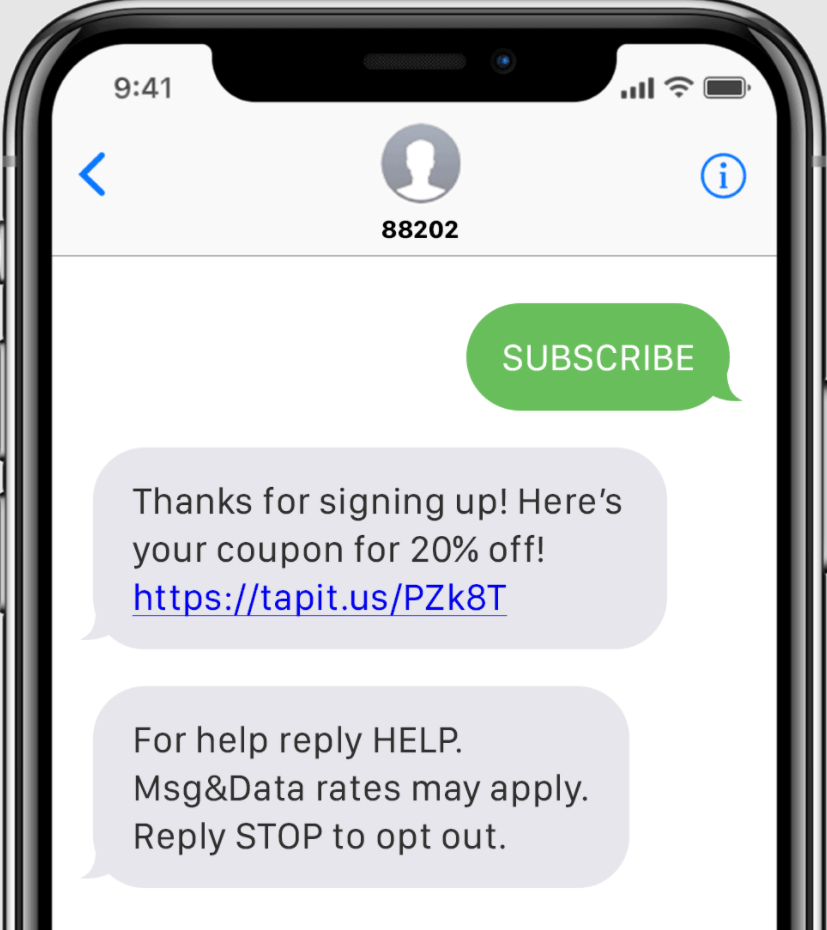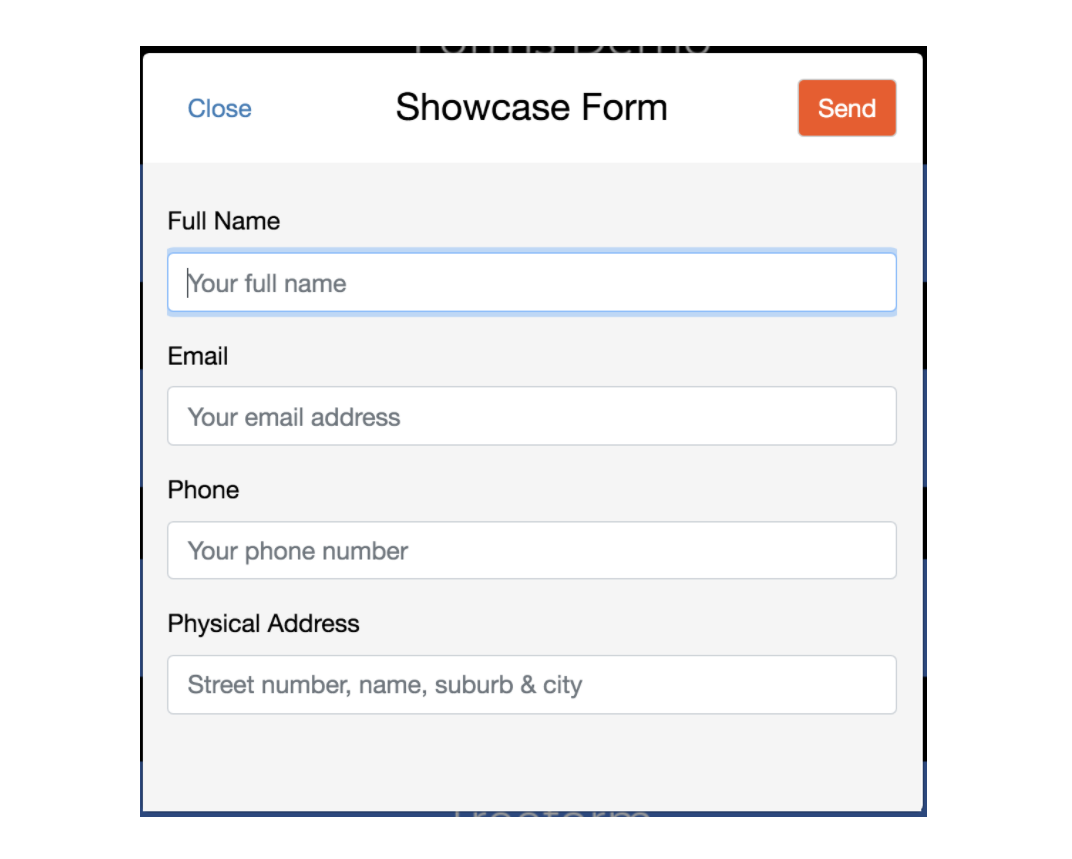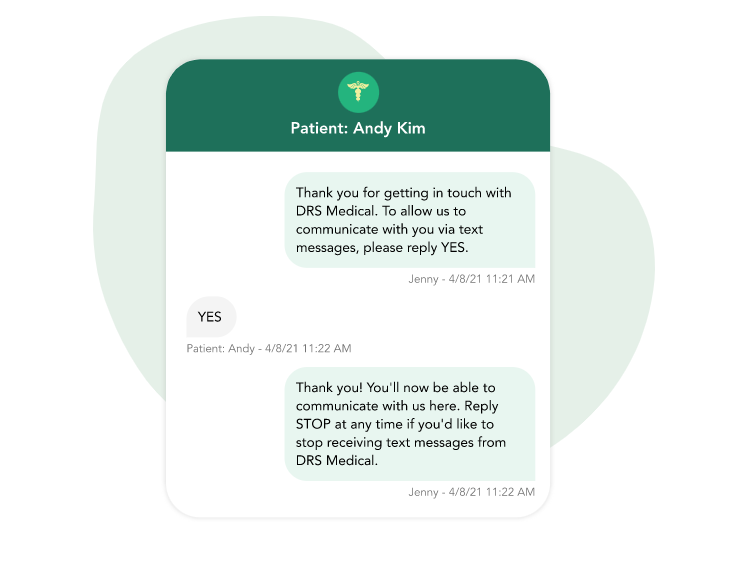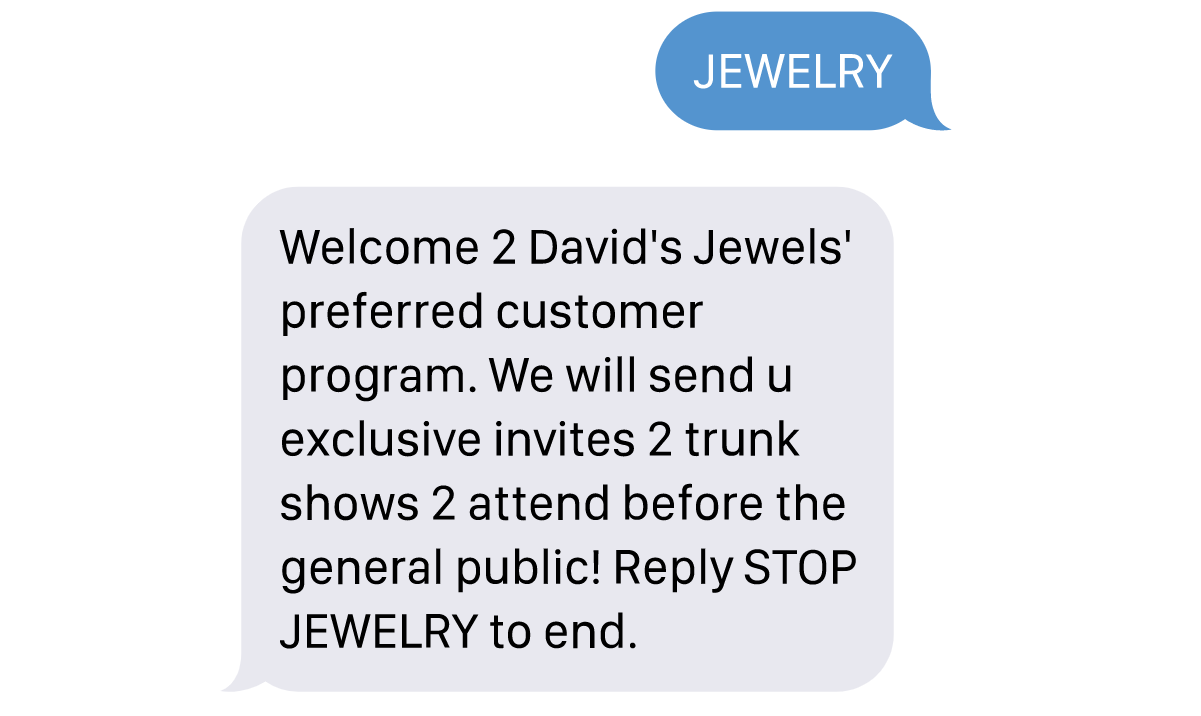SMS Marketing Opt-in: The A-Z Guide
Whether you’re crafting an email marketing campaign or an SMS marketing program, getting permission from your customers takes center stage.
That’s why SMS marketing opt-in has become so essential in recent years.
In this guide, we will talk about SMS marketing opt-in - everything you need to know, including what SMS marketing opt-in means, as well as how your business can use opt-in texting.
Let’s get going!
What is SMS marketing opt-in?
The word “opt” actually means to “make a choice.” Thus, an opt-in implies that recipients are choosing to subscribe to your texting communications. In other words, they are providing consent to receive your text messages.
This consent is essential because SMS marketing laws/rules require you to have express written consent to sign customers into a service.
Opt-ins are vital to the success of your business, 46% of customers say they would opt-in for texts from retail or E-commerce businesses. There are particular regulations around why and how you can reach people who have opted-in. For one, you must separately receive an opt-in for each communication channel. For instance, you can’t ask customers for consent to text them and use that same SMS consent to email them.
An opt-in does not necessarily have to be initiated in a text message from your customers, per se. Permission can be obtained in various ways, depending on your business and the type of text messages you intend to send. There are also different opt-ins, such as a single opt-in, double opt-in, HIPAA, etc.

The importance of SMS marketing opt-in
One of the biggest reasons why marketers use SMS marketing opt-in lies in how often people look at their phones.
Studies showcase the power of using texts in marketing communications, with 72% of millennials texting 10 or even more times per day. This opens up a host of opportunities for brands to reach customers about the latest deals or offer a few discounts.
Unlike marketing emails that usually get ignored or sales calls that most recipients find annoying, SMS marketing and opt-in text messages are received rather well. As a matter of fact, 77% of consumers positively perceive brands that use this tactic.
When it comes to coupons, those given to customers over texts are converted nearly 10 times the amount of traditional coupons.
This is all to emphasize that opt-in SMS messages, while cut from a similar cloth as email marketing, are becoming a popular, safe, and effective marketing method to reinvigorate prospects or existing customers.
Plus, the TCPA (Telephone Consumer Protection Act) has set regulations on the types of texts a company can send in the US. According to the TCPA, a business must acquire a customer’s contact information personally, and they can’t purchase a list of numbers to cold text. Any failure to comply with TCPA opt-in regulations can face a fine of at least $500, and you can even run the risk of damaging your brand’s reputation with customers.
Thus, SMS opt-ins are not only required by the law, but they are a measure of good business ethics.
The difference between transactional vs. promotional opt-in texts
A transactional and promotional text message may affect whether your business should send an opt-in text to your customers. To help you decide when to use an opt-in text, below is a quick overview of the difference between transactional and promotional SMS.
Promotional text messages
A promotional text message is a text that prompts customers to buy something, go somewhere, or otherwise take action. This can include text messages about discounts, flash sales, and promotions. Before a business sends a promotional text, they will need express written consent from the recipient.
A common way for brands to obtain consent is by advertising a keyword that people can text to opt-in for marketing texts. Via a text keyword campaign, the keyword can be advertised on a business’s website, via signs in-store, social media, digital and print advertisements, and even email. The text is initiated by the customer, so it can be assumed that they provide their consent.
When the keyword is sent to the advertised phone number, it should trigger an auto-reply response - the opt-in text message - that reiterates to recipients that they have given permission to receive marketing texts from the business. This method of delivering a follow-up text to confirm a recipient’s consent is known as a double opt-in text message.
Here is an example of a double opt-in SMS marketing:

The message emphasizes that the recipient can opt-out (unsubscribe) any time by replying with the word STOP. The opt-out language can be placed at the very end of the message and can be straightforward, such as “Text STOP to opt-out,” which gives clear instruction to the recipient.
Transactional text messages
A transactional text message is a text that is used when a company needs to provide necessary information to the recipient. These messages are often automated and can include order confirmation and tracking numbers, 2FA (two-factor authentication), and password resets.
In general, there is not a double opt-in text message involved for a transactional text because the customer can give the appropriate opt-in when they provide their phone number, like during the checkout process while placing an order online. The brand should clarify that if the customer provides their phone number, it will only be used to deliver relevant transactional text messages (e.g., no marketing text messages).

In the example of an online purchase above, a phone number may be used to send a confirmation of the order.
Two-way, conversational text messages
Another text scenario happens when the business and recipient are having a two-way conversation via text messages. Implied consent can be achieved within the course of a natural human conversation.
Per the TCPA, several examples can include:
- Customers may text your business first
- Customers may fill out an online form on your website
- You may have had a conversation with them before, where they consented to receive texts from you
In these scenarios, it is best to reply with an opt-in text message to confirm their permission to communicate via texts, also known as a double opt-in text message.
Opt-in text message examples
Keywords
To obtain the written consent needed to use text strategies legally, companies need to leverage dual opt-in measures to sign people onto their SMS marketing service.
However, with keywords, you can get that written consent right away. A text keyword is something that coincides with your marketing campaign, which can be texted to a short-code or long-code phone number to opt-in to an SMS marketing program.
For instance, a music store might sign customers onto their SMS marketing service by typing a word like “MUSIC” to a short digit number for special discounts on scores and instruments. Or, a pet store might also have your text “PETS” to 1-800-xxx to join their SMS list.

Forms
Another common way of opting customers into an SMS marketing service is through sign-up forms. Many companies embed numbers into their sites, allowing visitors to put in their phone numbers to sign up for their messaging service.
These forms can also be made sharable to let customers promote your services to others. They might be placed at the bottom of a web page or article, enticing visitors to fill out specific information to opt into an SMS marketing service.
Actually, forms don’t have to be digital. If you have got frequent in-store customers, they can fill out physical forms to subscribe to an SMS marketing service as well.

Website banners and pop-ups
While the term “pop-up” does not elicit the most positive responses, they are extremely useful for advertising things like SMS marketing programs.
When visitors are navigating through your site, they can occasionally receive a pop-up that allows them to sign onto a text messaging marketing service. They are quick and to-the-point and can generate conversions.
Some pop-ups can be designed to show up when visitors click away to another tab with a message like “Before You Go!” or “Wait!” and allow them to opt into an SMS marketing service.

SMS marketing opt-in templates
Your SMS marketing opt-in service is going to need several default templates for various situations. Below are some templates you can use to optimize your time.
Sign-up confirmation
When someone signs up for your text messaging service, it is essential to confirm that they actually meant to do so. Here is a good sign-up confirmation template you can use:
Hi {first_name}, thank you for opting in for SMS updates from {business_name}! Please reply with Y within 10 minutes to confirm. You can text STOP at any time to cancel.
Reminders
If you offer appointments and scheduled services, text reminders are key to reducing no-shows. Here is a good reminder template you can use for your opt-in text messaging service:
Hi {first_name}, {business_name} here! You scheduled an appointment with us for {date} at {time}. It’s at our office at {location}. Please reply to confirm or reschedule. Reply with STOP to quit or HELP to contact us now. Thanks!
Order confirmation
Ensuring that a customer knows their order went through is vital. Below is a solid order confirmation template for you:
Hi {first_name}. Your order #{order_number} has been confirmed. We will text you when it ships. Reply with STOP to unsubscribe from SMS notifications at any time.
Follow-ups
If customers used a chat function to talk with your customer support team, it’s a good idea to follow up with them to ensure they got what they needed. Here is a good follow-up template:
Hi {first_name}, this is {agent_name} from {business_name}. Did you have any more queries for us, or did you get the answer you needed?
Read more: 28+ SMS Templates for Marketing That You Can Apply Immediately
SMS marketing opt-in best practices
For your SMS marketing opt-in to work best, follow these tried and tested best practices:
1. Follow the rules
Generally, when someone asks to subscribe to your SMS marketing campaign, you’ll send them an SMS opt-in message. This is quite standard, but to give you an example, it’ll look something like this:
“Please reply YES to receive updates from {business _name}. Reply STOP to cancel, HELP for help.”
Right away, you’re establishing consent by having them reply YES while getting the legal talk out of the way and offering them further options.
That is a fairly standard message, so there is not a lot of creativity that goes into it. Nevertheless, you can start to define the campaign for them in your message and state your intentions.
Many businesses use double opt-in to make everything clear and legal. Double opt-in, meaning someone asks to join your list and then you reconfirm with the first message, is actually the best way to stay within the rules and build a professional relationship with your audience.

Again, as the opt-in is a legally required aspect of your text marketing campaign, it bears repeating. Actually, some businesses include a double opt-in even if their members already give their permission through a web form.
Not only does this cover you from legal repercussions, but it is also a simple best practice that is absolutely worth the time.
2. Be clear about your intentions
Have you even signed up for a newsletter, expecting a message twice per month, and instead began receiving one almost every day? Annoying, right?
The same can happen with SMS marketing unless you’re upfront about your intentions. This best practice is a simple tweak, but it can be a lifesaver.
Let’s look at the above text we sent again. This is really an opportunity for you to establish with your recipients the frequency of your messages. For instance:
“Please reply YES to receive updates from {business _name}. Approx 4 msg/month. Reply STOP to cancel, HELP for help.”
Right from the start, you tell them to expect 4 messages per month. Establishing this from opt-in will help retain subscribers.
3. Offer an incentive right from scratch
Once you’ve been through the process of getting consent for an opt-in, there are a few text opt-in best practices for sticking the landing.
One tip is to offer an incentive right from scratch. Think of this as a way of saying thank you. For example, if someone replies YES to your campaign, you can send them a message like this:
“Thanks for subscribing to {business_name}’s text reminders! Use the offer code SAVINGS for 20% off your next purchase.”
Right away, you’re cementing the relationship and showing the value of your SMS marketing program. Now, not only will customers be more receptive to your messaging, but they might even look forward to it.
4. K-I-S-S
Customers value SMS marketing due to the fact that it’s often quick and painless. When you start blowing up their inbox with lengthy text messages is when you’ll begin to lose them. Especially now when MMS (Multiple Messaging Service) is available, and links can be included in your message.
That’s where the K-I-S-S (Keep It Short and Simple) principle comes into play.
For example, instead of writing something like:
“{business _name}: Hi there! Did you know that you can save 30% this weekend when you shop in our stores? Remember to mention our texting campaign at the register!”
You could follow the K-I-S-S principle and write something like this:
“{business_name}: Save 20% off this weekend! Show them this message or go to {link} for more details.”
As you can see, both convey the same point, but in a much simpler fashion that will likely lead to higher conversions.
5. Choose the right keywords
Even though it might not make sense to try and create a shortcode that spells something out, SMS marketing keywords are another story. These keywords are what recipients will use to reply to you as well as trigger automated responses.

STOP and HELP are used in almost every SMS marketing campaign. However, you can generate branded keywords that make things easy for your recipients. For instance, “Text WORKOUT to 12345 for more information on gym membership.”
As the keyword is in line with the information you hope to receive, your recipients will have an easier time getting started.
Below are some considerations when you create your keywords:
- Keep it less than roughly 6-7 letters and ensure that it isn’t close to another keyword you’re already using. This will make sure that your subscribers don’t become confused or frustrated.
- Create memorable and easy to spell keywords
- Branded keywords are preferable, but ones that are generally related to your business can also work
- Avoid special characters
- Avoid words that have homonyms
6. Measure everything
Another best practice that almost goes without saying is to measure everything.
Although you might be able to set up most of your SMS campaign when you first get started, building an exceptional process takes time and maintenance throughout. By measuring your campaign results, you can perform A/B testing and hone your craft.
For example, this text message:
“{business_name}: Thanks for subscribing! Find more information at {link}”
Might perform better than this message:
“{business_name}: Thank you for subscribing! Make sure to check out our official website for more information”
Although they’re almost the same, without the right tools for measuring this, you wouldn’t even know. Ensure that whichever SMS marketing software you’re using allows you to track your user engagement metrics. These will be really invaluable to you and your company moving forward.
7. Always provide a way out
Under the TCPA, your subscribers must always have an easy, straightforward way out. The part at the end, “STOP to cancel,” is essential. Even your most dedicated subscribers need to know that they have a way out. Ensure that you include this in regular messages so that your recipients don’t feel as if you’re trying to work one over on them.
The bottom line
As you can see, while SMS marketing may seem to be a simple process from the outside, there’s a lot of thought and time that goes into crafting an exceptional campaign.
We hope you’ve learned useful things via this SMS marketing opt-in guide. Contact us if you’d want to know more information about this topic. Thanks for reading!
New Posts







